P2P Download
How to Use P2P Download Independent of Computer by QNAP Turbo Station :
P2P Download
Peer to Peer download is widely used in recent years. The exchange packets of P2P download have occupied a high ratio of data flow on the Internet. BitTorrent and Emule P2P are well-known network download technology and have become the main exchange and sharing platform among computer users nowadays. Since the download rate of P2P is fast and the cost of network structure is relatively low, it is planned that P2P is applied in sales and provision of digital services.
Many users who download files frequently tend to use a PC that runs 24×7 for long-term download. However, users may suffer from high electricity expense and loud noise of the fan.
P2P Download NAS Independent of PC- QNAP Turbo Station
QNAP Turbo Station supports P2P, FTP and HTTP download, providing users a different choice. QNAP Turbo Station is embedded with BitTorrent download client. Simply connect Turbo Station to the network and enable Download Station, Turbo Station can download files independently without PC.
- The advantages of using QNAP Turbo Station for file download:
- Simple activation: By enabling the embedded Download Station of Turbo Station, file download can be executed directly. Users don’t need to install any other software on Turbo Station.
- Simple web management interface: Management of Turbo Station download tasks can be completed via web browser. You can manage the download tasks via the Internet anytime, anywhere.
- Convenient QGet software: QNAP provides an easy-to-use and powerful QGet software for you to manage the download tasks of multiple Turbo Station (or TS-201) simultaneously on the same PC from LAN or WAN. You can manage your download tasks from school or office. QGet supports intuitive drag and drop of torrent file, HTTP or FTP URL to the software interface for convenient adding of download tasks.
- Stable and energy-saving: Turbo Station adopts embedded hardware design which is stable and energy-saving. The power consumption is about 15~25W. (only 14.4W for 1-bay NAS) Compared to a PC server, Turbo Station helps you save electricity expense in a large extent.
- Silent: Turbo Station uses aluminum alloy case for heat dissipation and employs fanless design which is absolutely quiet to use. You can turn on the server for 24 hours and the server will not generate any noise to disturb your work or rest.
- Small-sized, occupies small space only. It is easy for you to place it anywhere.
How to configure:
- Set up Turbo Station in a few simple steps

- Install a hard disk to Turbo Station and finish initialization according to the Quick Installation Guide.
- Make sure you have connected a PC and Turbo Station to the same LAN. Execute QNAP Finder (the configuration utility provided by QNAP) to find your QNAP Turbo Station in LAN to enter Turbo Station’s web administration page.
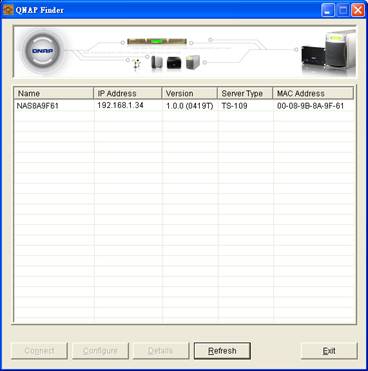
The server will pop up a window and prompt for user name and password. (TS-109 and TS-209’s default user name: admin, password: admin).
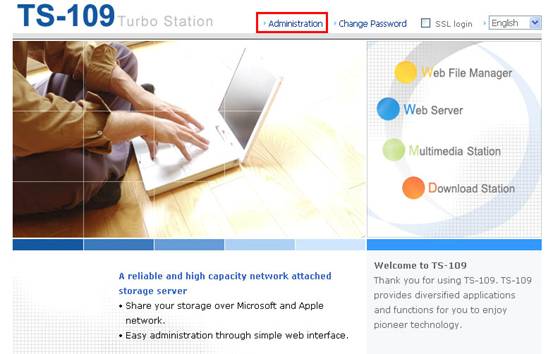
- It is recommended to assign a fixed IP to Turbo Station. (Since you may need to open the ports of some services on your NAT router and forward them to the fixed IP address of Turbo Station.) Go to Network Settings>TCP/IP Configuration. If your gateway address is 192.168.1.1, you can assign a fixed IP to Turbo Station, e.g. 192.168.1.34, and set the subnet mask as 255.255.255.0. Note that the LAN IP of Turbo Station should be in the same LAN of the NAT router. Besides, to make sure the Download Station function works, please be sure to input DNS server address. The DNS information is provided by your ISP. (e.g. 168.95.1.1)
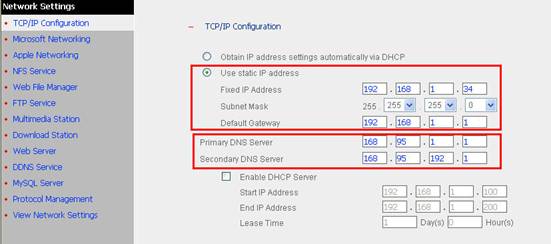
B. Finish the IP sharing router settings (DDNS and port forwarding settings)
- DDNS (Users using fixed IP for Internet connection might not need this service)
Most ISP will provide one or more dynamic public IP for Internet connection. (This applies to the situation that the IP sharing router acquires WAN IP from ISP by PPPoE or DHCP connection.) To set up a server, a fixed IP address or URL is necessary so that users can easily recall the server address to connect to. When a dynamic IP address is used, you can use a DDNS supported IP sharing router with Turbo Station or use Turbo Station’s DDNS function, and register an easy-to-remember address from DDNS provider to identify Turbo Station on the Internet, e.g. myTurboStation.dyndns.org.
If you are using your Turbo Station without being behind an NAT router, you can also configure to use the DDNS function on Turbo Station.
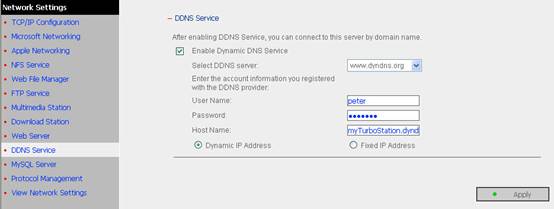
- Port Forwarding
If your Turbo Station is located behind the NAT router, you need to open the ports of some services on the NAT router and forward these ports to the fixed LAN IP of Turbo Station. This function is available on most routers in the market and is often known as “Port Forwarding“, “NAT Server” or “Virtual Server“. Take BitTorrent download function as an example, you have to forward the port range of BitTorrent service to the LAN IP of Turbo Station, e.g. forward port range 6881~6999 to 192.168.1.34. When your NAT router receives external port 6881~6999 packets at WAN side, the router will forward these packets to the LAN IP of Turbo Station. Moreover, to connect to the Turbo Station at home from WAN, you can simply open port 8080 (the TS-109 and TS-209’s default management port; or port 6000 of TS-101, TS-201, or TS-100) and forward the port to the LAN IP of Turbo Station.


PS: Some NAT routers provide DMZ settings. You can forward LAN IP address specified by DMZ to Turbo Station. When this setting is used, all ports from WAN to LAN will be forwarded to Turbo Station.
- Turbo Station’s Download Station function supports UPnP NAT Port Forwarding of BT download. If your NAT router supports UPnP, you can enable UPnP on NAT. Turbo Station can then automatically notify NAT router to open the corresponding ports when performing BT download. There is no need to enter the port range for BT download on NAT router by enabling this option.
PS: Some NAT routers provide DMZ settings. You can forward LAN IP address specified by DMZ to Turbo Station. When this setting is used, all ports from WAN to LAN will be forwarded to Turbo Station.
After completing these two settings, you can connect to the Turbo Station at home from the Internet via http://myTurboStation.dyndns.org:8080/ and manage the server.
C. Step-by-Step Configuration of Download Station
- Enter the administration page of Turbo Station:
- Click Administration to enter the administration page.
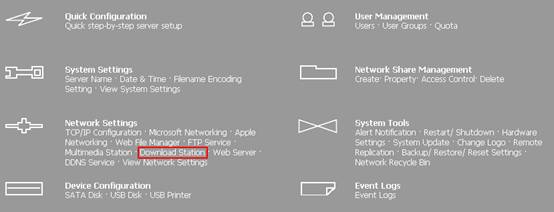
- Enable Download Station
- Go to Download Station in Network settings.
- Check the box “Enable Download Station” and click Apply. Download Station is then activated.

- Configure Download Station
- After enabling Download Station, you can click on the link http://Turbo Station IP:8080/Qdownload/ to enter Download Station page.
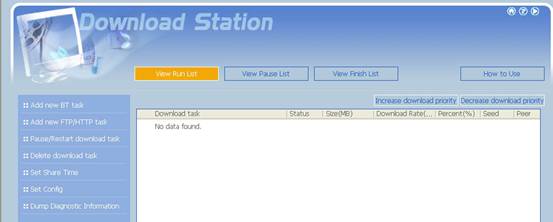
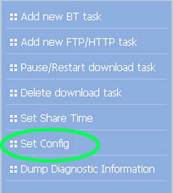
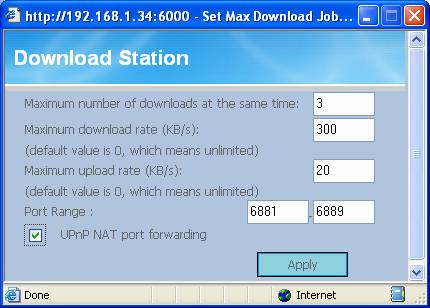
Click Set Config.
-
- The maximum number of downloads at the same time is 10. We recommend that you set 3 or less as the concurrent sessions for this setting for faster download performance.
- Set maximum download and upload rates.
- The port range is the port numbers used by BT download. If your NAT router supports UPnP, it is recommended that you enable “UPnP NAT port forwarding” or open the port range on NAT router manually. For example, forward ports 6881~6999 to the LAN IP of Turbo Station: 192.168.1.34.
D. Add a BT task
-
-
- You can search for the torrents you need on the Internet, e.g. http://www.bittorrent.com/. In this example, we selected a Casper cartoon. Click Download to download the torrent file.
-

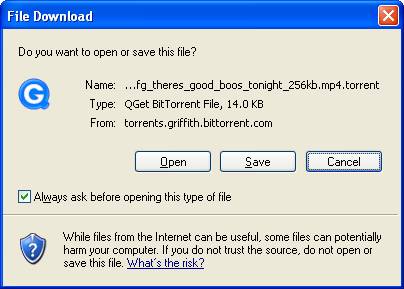
-
-
- Go to Download Station page and add a BT task. Select the torrent file you have just downloaded.
-
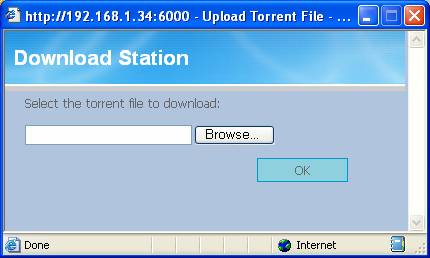
-
-
- After you add a torrent, the task and the download status will be shown in the View Run List.
-
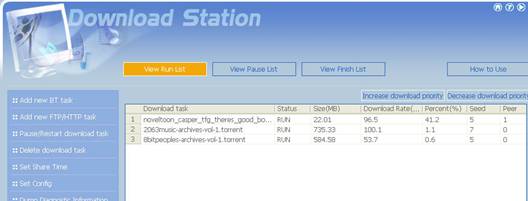
-
-
- When the download task completes, the task will be moved to Finish List and the downloaded file(s) will be saved in Qdownload folder on Turbo Station. The system will generate a folder named after the torrent file in this network share. You can access the downloaded file(s) via My Network Places or FTP.
-


-
-
- You can click on the file to view the video.
-


Some files may be very large in size, esp. video files, and the download time will be relatively longer. You can let Turbo Station finish the download independent of computer. You can access Turbo Station to manage the download tasks from the web anytime, anywhere.
Besides web administration interface, QNAP also provides a Windows software QGet. QGet enables users to manage the download tasks of multiple Turbo Station (or TS-201) simultaneously on the same PC from LAN or WAN. You can manage your download tasks in school or at work. QGet supports intuitive drag and drop of torrent files, HTTP or FTP URL to the software interface for convenient adding of download tasks.
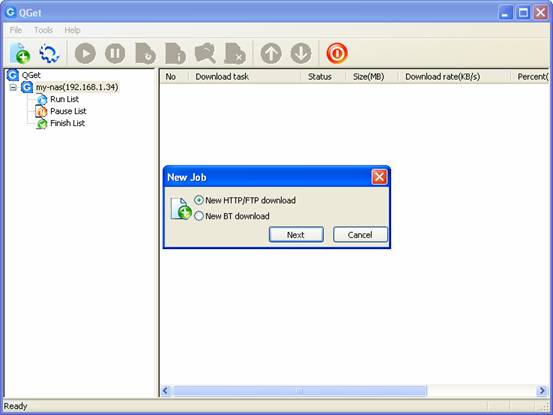
Conclusion
Free and legal contents for BT download are now widely available on the Internet. BT download is one of the powerful functions of QNAP Turbo Station. The web-based configuration is simple and easy-to-use, and can be managed by anyone. Moreover, Turbo Station’s energy-saving, fanless, and aluminum alloy case design enable absolutely silent and stable performance for long-term download. With Turbo Station multimedia sharing function, the downloaded files can be applied in DLNA home network. Mp3 can be played by stereo acoustic system, and video files can be played on TV. Turbo Station plays a key role to connect these applications. It makes your digital home life more wonderful.